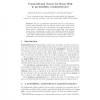ICALP
2010
Springer
14 years 10 months ago
2010
Springer
Higher-order process calculi are calculi in which processes can be communicated. We study the expressiveness of strictly higher-order process calculi, and focus on two issues well-...
ICALP
2010
Springer
14 years 10 months ago
2010
Springer
We give a quantitative sequential model for noninterference security with probability (but not demonic choice), and a novel refinement order that we prove to be the greatest compo...
ICALP
2010
Springer
14 years 10 months ago
2010
Springer
We prove that TAUT has a p-optimal proof system if and only if a logic related to least fixed-point logic captures polynomial time on all finite structures. Furthermore, we show ...
ICALP
2010
Springer
14 years 10 months ago
2010
Springer
Abstract. Asynchronous automata are parallel compositions of finitestate processes synchronizing over shared variables. A deep theorem due to Zielonka says that every regular trac...
ICALP
2010
Springer
14 years 10 months ago
2010
Springer
Graph transformation works under a whole-world assumption. In modelling realistic systems, this typically makes for large graphs and sometimes also large, hard to understand rules....
ICALP
2010
Springer
14 years 10 months ago
2010
Springer
Universal Coalgebra provides the notion of a coalgebra as the natural mathematical generalization of state-based evolving systems such as (infinite) words, trees, and transition s...
ICALP
2010
Springer
14 years 10 months ago
2010
Springer
We investigate the decidability and complexity of various model checking problems over one-counter automata. More specifically, we consider succinct one-counter automata, in which...
ICALP
2010
Springer
14 years 10 months ago
2010
Springer
We show that the downward-closure of a Petri net language is effectively computable. This is mainly done by using the notions defined for showing decidability of the reachability...
ICALP
2010
Springer
14 years 10 months ago
2010
Springer
Abstract. This paper tackles three algorithmic problems for probabilistic automata on finite words: the Emptiness Problem, the Isolation Problem and the Value 1 Problem. The Empti...
ICALP
2010
Springer
14 years 10 months ago
2010
Springer

